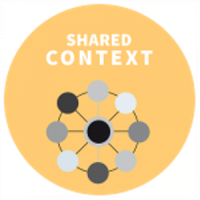Complex, Meidoornkade 22
3992 AE Houten
0343 528 040
3992 AE Houten
0343 528 040

A context is our personal story, perception or experience that frames the way we think and act. In groups the collective context, a coherent and shared ‘big picture’ of results and approach, stimulates co-creation and the willingness to participate.
The success strategy: We all recognize the big picture and we are willing to work together towards a collective outcome. We can discuss this factor using the following success markers: Shared vision, Coherent overview, Interdependencies, Motivating outcome and Translate big picture

Activate thinking patterns that are aimed at people and results using questions such as:
Use methods for

Many professionals seem to be puzzled about the overall coherence of a team effort. Despite a global view on deliverables the specific interdependencies with other co-workers are not clear enough to create that coherence. This results in rework and stress. This could be solved by collective learning and knowledge transfer.
Activate a way of thinking that connects the dots. Combine conceptional thinking with a sense for structure and details.
Activation questions:
Apply specific templates or structures for:

Much time and money is lost because interdependencies between people, systems and tasks are not known. This creates rework and hampers the quality of work. From a survey among 500+ professionals it shows that 34% is convinced but 25% is not convinced that alle team members know their task and interdependencies.
Find interdependencies by focusing on practical use and the group by using these awareness questions:
Create clear definitions of the scope of work, the roles involved, groups tasks and individual tasks.
Use tools to:

This is the number one success marker according to 500+ professionals in the survey. Many people are motivated to contribute because they feel that the results matter. It shows the importance of having a shared vision on results and the values for the business ecosystem. The most important resources for this success marker appear to be authentic action.
Focus on the future, purpose, and the value for others.
Focus on the ‘business eco-system’.
Ask others why the team outcome is important and for who.

Most projects and groups are organized according to a top-down principle: Goals – Deliverables – actions. When team members are unable to translate the bigger picture into smaller tasks, this principle fails, and successful results are unreachable. Research show that 29% of the professionals is unsatisfied.
Frequently shift focus between the bigger picture and small tasks.
Review your work from the perspective of others to obtain the bigger picture.
Be specific about your own task and find the link between your own perspective and the perspective of others.
Ask the HOW-question: How do we translate this big picture to small steps?
Apply methods for setting up a customer journey and for analyzing stakeholders and processes.
Rien van Leeuwen gaat in op basiscondities voor duurzame verandering.
Aan de hand van praktijk-cases verkennen we de barrières bij het bereiken van duurzame doelen op strategisch, tactisch en operationeel niveau. Denk hierbij aan bestaande structuren en opvattingen, maar ook aan het niet kunnen duiden van negatieve en positieve impact.
We delen onderling de best practices en interventies die anderen activeren. Uiteindelijk draait elke verandering om een andere manier van interactie.
Rien van Leeuwen gaat in op basiscondities voor duurzame verandering.
Aan de hand van praktijk-cases verkennen we de barrières bij het bereiken van duurzame doelen op strategisch, tactisch en operationeel niveau. Denk hierbij aan bestaande structuren en opvattingen, maar ook aan het niet kunnen duiden van negatieve en positieve impact.
We delen onderling de best practices en interventies die anderen activeren. Uiteindelijk draait elke verandering om een andere manier van interactie.